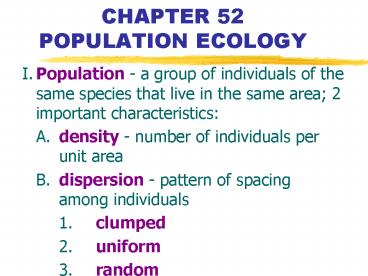CHAPTER 52 POPULATION ECOLOGY - PowerPoint PPT Presentation
1 / 7
Title:
CHAPTER 52 POPULATION ECOLOGY
Description:
... survivorship curves. a. type I survivorship curve. b. type II survivorship ... c. type III survivorship curve. demography (cont.) 3. population growth models ... – PowerPoint PPT presentation
Number of Views:114
Avg rating:3.0/5.0
Title: CHAPTER 52 POPULATION ECOLOGY
1
CHAPTER 52POPULATION ECOLOGY
- I. Population - a group of individuals of the
same species that live in the same area 2
important characteristics - A. density - number of individuals per unit
area - B. dispersion - pattern of spacing among
individuals - 1. clumped
- 2. uniform
- 3. random
2
Population Ecology (cont.)
- II. Populations change in 2 ways
- A. change in population size the study of
vital statistics (birth death rates and
emigration immigration rates) that affect
population size - demography - B. evolution - Chapter 22-24
3
A. demography
- 1. age structure sex ratio
- 2. life tables survivorship curves
- a. type I survivorship curve
- b. type II survivorship curve
- c. type III survivorship curve
4
demography (cont.)
- 3. population growth models
- a. exponential growth - population grows at
its maximum rate intrinsic rate of
increase (rmax) - b. logistic growth - incorporates effect of
population density on r r0 at carrying
capacity (K)
5
demography (cont.)
- 4. population limiting factors
- a. density-dependent factors
- b. density-independent factors
6
B. evolution - life history
- 1. patterns in life history traits
- 2. trade-offs constraints
- 3. life history traits
- a. number of reproductive events per
lifetime semelparity vs. iteroparity - b. number of offspring per reproductive
event - c. age at first reproduction
7
life history (cont.)
- 4. two extreme life history strategies
- a. K-selected populations - maximize
competitive ability efficiency of resource
utilization - b. r-selected populations - maximize
fecundity rate of maturation































